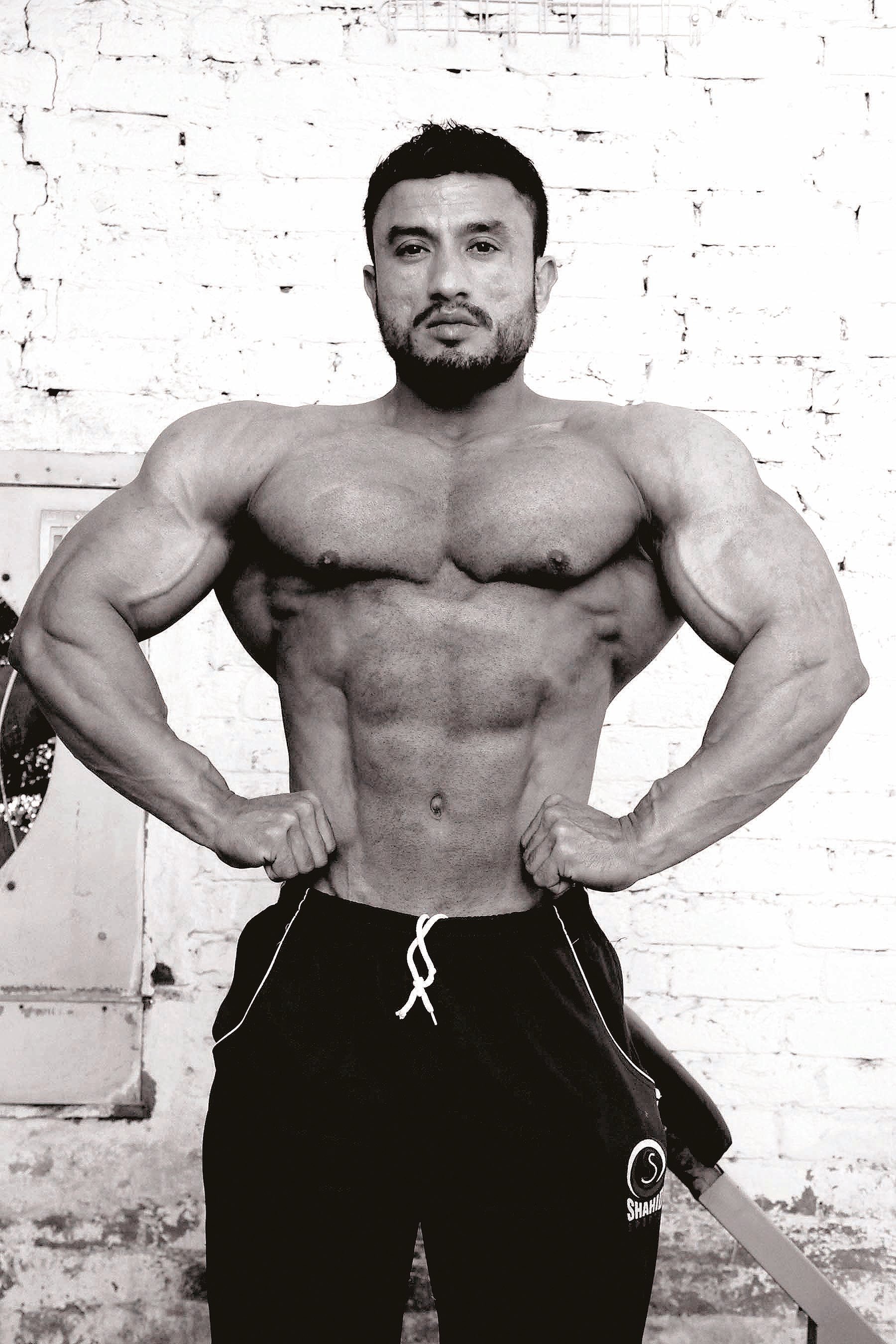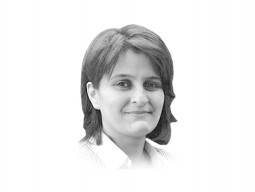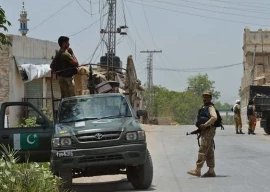

Runner-up at the 2014 Mr Pakistan competition held at Al Hamra Hall, Lahore in February. PHOTOS: SHAFIQ MALIK
Bare minimum
Even though the competition for the title of Mr Pakistan first started in Pakistan in 1954, it did not get much attention until the late 1980s. It was only after an array of bodybuilders from the country competed on international forums (such as Mr Asia, Mr South Asia, Mr Olympia) that the sport gained traction locally as well. But the sport never became mainstream, since it was reported that the ulema council under the Zia era had banned it from being shown on national television, due to the men’s attire in the competition. Hence, bodybuilding has had little audience throughout most of its existence.

But that has failed to deter contestants who train meticulously for months to become the next title holder. To qualify, a bodybuilder must perfect the following seven poses: front double-biceps, front lat-spread, side chest, back double biceps, back lat-spread, side triceps and abs and thighs. The judges rank contestants based on symmetry, proportion and the size of each muscle group. As Arnold Schwarzenegger once alluded, a bodybuilder is like a sculptor, since he perceives his body as something that can be continuously molded and shaped into perfection.

Steroid usage has led to the downfall of several Pakistani bodybuilders. PHOTOS: SHAFIQ MALIK
Khan’s case is no different. Hailing from the humble neighborhood of Ichra in Lahore, he first started training at the age of 15. Since he worked as a warehouse lifter during the day, he had little option but to go to a single-room gym nearby at night with four of his friends. Even though the gym offered minimum facilities, Rs100 a month was all Khan could spare to feed his passion. Over time, he began participating in district competitions and worked his way up the bodybuilding ranks to the city level.
Despite years of experience in the field, Khan can still barely sustain his training costs and depends on a well-organised local support network of veteran bodybuilders who have opened up gyms and support young talent. “To be Mr Pakistan, you need a lot of will and money. People ask me if I train and compete to make the country proud,” says Khan. “But this country takes down people like me so I guess it’s for myself more than anything.”
Fat Busters
When it comes to bodybuilding, Lahore is seen as the hub, as it has produced the highest number of Mr Pakistan title-holders. The city boasts a rich history of masculinity and machismo derived from the sport of wrestling or pehlwani. Gawalmandi, the central part of Lahore, is not only known for its food culture but also for being home to the Bholu wrestling clan. However, with time, wrestling has been replaced by the culture of bodybuilding.

“This is a working class sport,” says Sheikh Farooq Iqbal, general secretary of the Pakistan Bodybuilding Association (PBBA). “You will see everyone from sanitation workers to labourers in this field. Despite the high costs, you will see that bodybuilding is flourishing everywhere in Pakistan, from urban centres like Lahore to small towns like Mardan, Chaman, Loralai, Swat, Larkana, Sukkur and Hyderabad. This is something that sports like cricket cannot boast.” Bodybuilding is immensely popular in the lower middle and lower income classes, but has never earned the same prestige in the more affluent sections of society who may lift weights within the confines of their gyms but have never endorsed it at a public forum.
In small mohallas, however, gyms are seen as a positive sign, as they promote fitness and keep the young men from falling prey to drugs, weapons and crime. “If you look at the history of professional bodybuilding, none of them have been associated with crime. It is an activity that promotes positive thinking,” says Khalid Malik Nawaz, who has trained Khan and runs a small gym in Rehmanpura, Lahore.

Gyms in small mohallas have seen a massive influx of young men over the past three decades. Not only do these gyms promote fitness, but prevent young men from turning to drugs, weapons and other crimes. PHOTOS: SHAFIQ MALIK
Nawaz, a former national champion, opened Shaukat gym after retirement, which has produced several of Pakistan’s best bodybuilders. “It used to be the kind of place where we had to stop training every time it rained. There were no big halls or air-conditioning or any cover,” he says. Since its inception in the late 1990s, the small gym, which could easily be mistaken for an industrial warehouse, has been a nursery for several national champions and Mr Pakistans over the years. Some of the most prominent names include Ashfaq Butt, Muhammed Hanif, Shoaib Zahoor, Mudassir Khaliq, Amanat Ali and the current Mr Pakistan, Abbas Khan.

Khalid Fitness Center, located in Rehmanpura, Lahore, has produced many bodybuilding champions including Abbas Khan. PHOTOS: SHAFIQ MALIK
During the early 1980s there were only three gyms in the city. Today, Lahore alone has around 500 gyms, which are loosely associated with the PBBA. The growth of gyms and the fitness industry has not been limited to Lahore however and has burgeoned throughout the country.
The quality of gyms started to improve during the 1990s with the opening of Gold’s gym in Lahore, which catered to a higher income class. The rise of cable television and the internet exposed testosterone-fueled young men to the likes of Salman Khan and Arnold Schwarzenegger.
Yahya Butt who was Mr Asia thrice and also won the Mr Pakistan title five times was one of Schwarzenegger’s most ardent followers. Butt is credited for introducing workouts based on Schwarzenegger’s encyclopedia of bodybuilding in high-end gyms like Gold’s and later on, Shapes.
As more educated and affluent men picked up weights, the line dividing brain and brawn started to fade and the mindset about bodybuilding began to evolve. “When we started bodybuilding, people thought of us as gangsters,” Butt speaks of the earlier days. “We made a conscious choice of not wearing skin-tight clothing and wandering outside girls colleges because we loved the sport and wanted to transform its image.”
But his passion could not steer him clear of controversy. After having tested positive for steroid use, he was twice banned from competing between 1988 and 1991. The Pakistan Olympic Committee and the PBBA also had to distance themselves from him in the long run and the Yahya Classic (a promising annual event named after Butt in the 1980s) went under the radar.

Ripped glory Abbas Khan after winning the title of Mr Pakistan 2014. PHOTOS: SHAFIQ MALIK
Butt is however, not the only one who has fallen victim to the culture of supplements in the race to push his body to the limit. In 2011, Muhammed Shafique who was made Mr Pakistan thrice died of a heart attack on the night before a competition in Badin. To date, there has been little clarity on the cause of his sudden demise.
Blood, sweat and tears
As with every other industry, bodybuilding is also torn by internal politics. Currently, there is a tug-of-war between two groups; one of them is headed by General (retd) Arif Hassan while the other is led by Major General Akram Sahi. The split threatens their chance to participate in the Olympics (for Pakistani bodybuilders). It also means that two major associations aside from the International Olympics Committee-sanctioned PBBA, Butt’s Lahore Bodybuilding Association and Masoom Butt’s small organisation, are all holding Mr Lahore competitions and vying to be the sole representatives of the sport. At a local level, the schisms between the various associations do not have much of an impact as it only provides more avenues for bodybuilders to compete. However, the lack of unity has constrained Pakistani bodybuilders from rising to international fame.
Not only does the industry lack institutional infrastructure, it provides little payback to those who brave these circumstances.
The history of bodybuilding is replete with stories of former national bodybuilders who have fallen back into poverty due to a lack of financial compensation for the sport. One of the primary examples is Rifaqat Ali, a former Mr Lahore, Mr Asia, and national champion who now drives a rickshaw in the old city.
The costs of the sport cannot be borne through the current prize money since the diet alone costs around Rs3,000 to Rs4,000 per day.
According to former Mr Pakistan, Imran Qureshi, mental acumen is as important as physical strength, if you want to excel at the sport. “If you are really passionate, you will try to understand the constraints and work to find a balance,” he says.
One of the ways bodybuilders can sustain themselves is by making a name for themselves in the industry and using it to train others. “Being Mr Pakistan is a lifetime achievement and your name goes down in the records. You can use this professional credit to train others and make a living for yourself,” explains Qureshi.
Like many former athletes, he owns a gym in Iqbal Town, Lahore, which is constantly swamped by 30 to 40 young bodybuilders, who pay a minimal fee but benefit from Qureshi’s vast experience and mentorship.
Machismo 3.0
Until a few decades ago, masculinity manifest itself in the form of pehelwans, derived from kushti or wrestling. With time, however, bodybuilding has been accepted as the alternate form of manliness. It is now seen as a move towards sophistication — a culture of young males shunning a life of indiscipline and delinquency for a life of commitment, training regiments and physical perfection. However, until the sport is promoted locally and the sportsmen compensated duly, our male Adonis will remain trapped in dingy gyms and narrow alleys.
Sher Ali is a culture reporter for The Express Tribune. He tweets @sherakhan46
Published in The Express Tribune, Sunday Magazine, February 23rd, 2014.
COMMENTS (11)
Comments are moderated and generally will be posted if they are on-topic and not abusive.
For more information, please see our Comments FAQ










































Keep going. Thanks tribune to highlight the above. Its wonderful to see some good news
@ ALI... please dont come up with this non-sense of Islamic Republic of Pakistan... why do we have to drag relegion in everything? that means swimming, wrestling and all such sports shall be banned?? there is NO Islam left in this country and no republic... STOP POLITICIZING EVERYTHING!!!
If a Miss Pakistan is fahash then so is a Mr. Pakistan. This sort of thing shouldn't be allowed in the Islamic Republic. Double standard.
Neither are a lot of other sports. While one can argue that bodybuilding is more of a male beauty contest, several bodybuilders also do the olympic weightlifting movements (http://en.wikipedia.org/wiki/Olympic_weightlifting) as well as powerlifting exercises (http://en.wikipedia.org/wiki/Powerlifting).
While this may be the case, steroids are NOT inherently dangerous and do not cause organ failure, hormone imbalances or early death if used correctly. Bodybuilding does get the stick when it comes to steroids, but performance enhancing drugs are a part of every sport; yes, every single contact/ endurance/ power sport. It's not difficult to cheat drug tests; in most cases you just need to stop taking drugs a suitable amount of time before the contest.
Now thank me for enlightening you. takes a bow and disappears in a flash of lightening.
Celebrating naked men in tiny underwears in Islamic Republic of Pakistan, two nation theory lie dead.
I wish I could help financially this handsome man. Bravo good luck to you! U are just unlucky to be here. However Some body must sponsor him. Police should recruit him in force what is wrong in it?
Bodybuilding is not an olympic sport.
Being my self a bodybuilder from middle east, i can say this sport costs a lot and at professional level whopping costly. Hats of to these guys who spend there hard earned money on it they are the one who are truly driven by passion do doubts, had there been any govt support Mr Olympia title could easily be ours such is a passion these athletes have.
SHarif family must not ignore that spirit of Pakistani people.